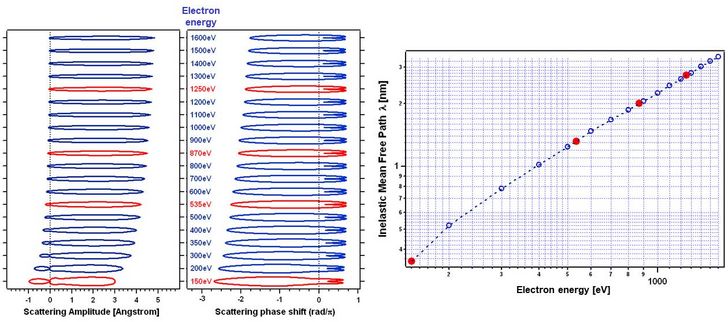LEED
Interaction of electrons with solid surfaces
Electrons impinging on a sample surface potentially undergo different processes of interaction. The electron can be absorbed, inelastically scattered under excitation of an electron of a single atom, leading to Auger-electrons or self-ionization, or under excitation of the collective electron gas (plasmon excitation), or under excitation of phonons. Finally the scattering can also be elastical with subsequent superposition of the different electron waves, better known as electron diffraction. Which of the processes is dominant depends on the sample surface, the incident angle and the kinetic energy of the impinging electron. In case of elastic scattering this energy dependence is shown in the set of polar plots of the scattering amplitude and scattering phase shifts for different electron energies between 150 eV and 1500 eV. Obviously backscattering is strong at low energies (like in LEED) and forward scattering is strong at high energies (like in RHEED). This, and the fact, that the penetration depths is increasing with increasing energies, it has consequences for the geometry of the experiments discussed in the following paragraphs.
Low Energy Electron Diffraction (LEED)
In Low Energy Electron Diffraction (LEED) the electrons of kinetic energies between 10 eV and 150 eV are emitted from an electron gun impinging normal to the sample surface and - utilizing the high back scattering cross section - the backscattered electrons are filtered for suppression of the inelastically scattered electrons by a retarding field analyzer and after acceleration finally detected on a rear view fluorescent screen. The diffraction pattern represent the reciprocal space of the surface mesh of the unit cell, including reconstructions. It documents the long range ordering of the sample surface, rather than the local structure. If intensities are followed as a function of the electron energy (I-V analysis), relaxations and the base of the unit cell can be determined. Most frequent use is the assessment, if a sample surface or thin film is well prepared and has the correct orientation prior to further studies of the local or electronic structure.


